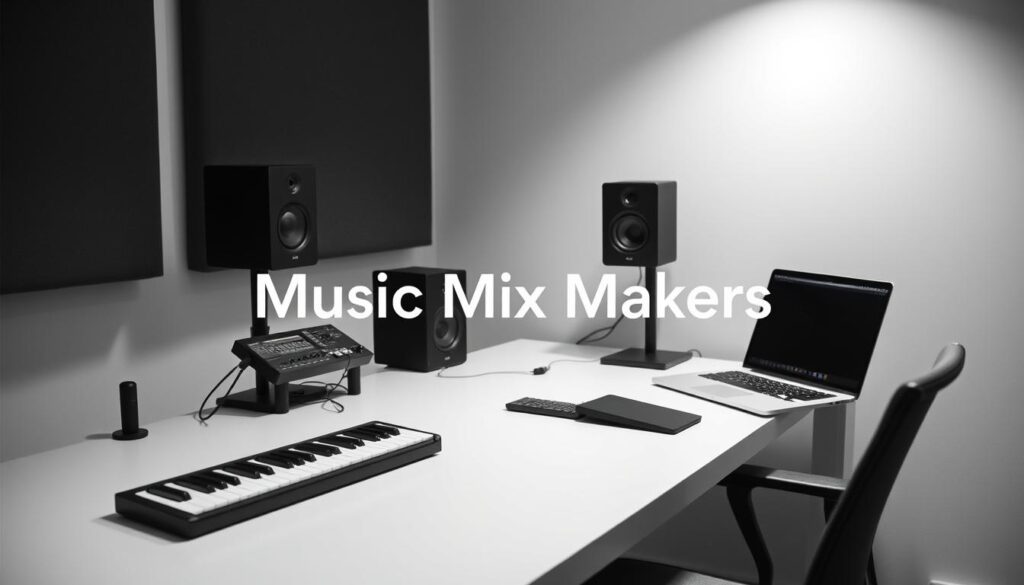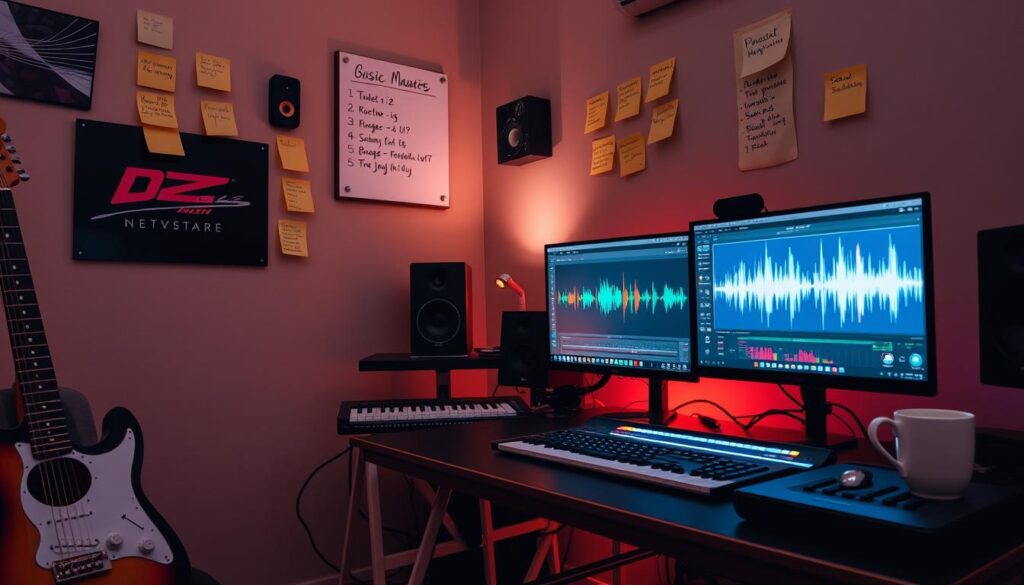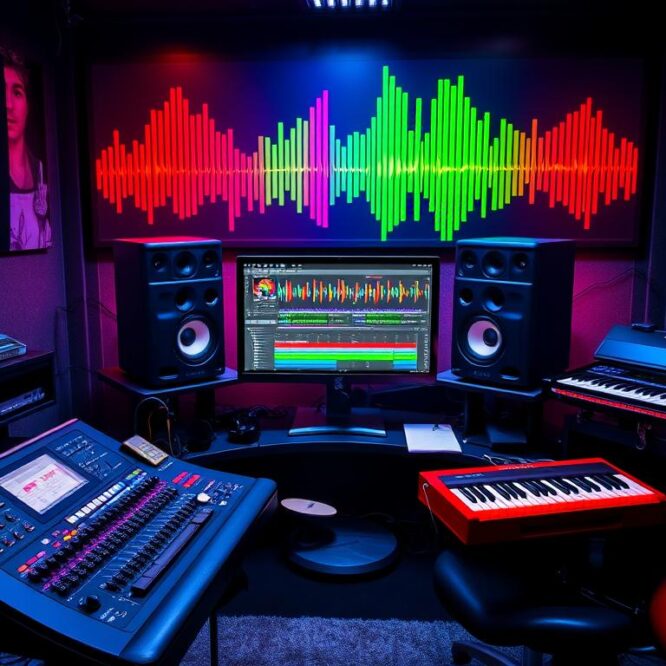As a budding music producer, I understand the excitement and challenges that come with starting your journey in the world of audio engineering. Whether you’re interested in beat making, full-scale production, or even mixing and mastering, the foundations you build early on will significantly impact your growth and success. In this article, I’ll share 10 essential music production tips that have helped me navigate the field as a beginner, and I hope they’ll do the same for you.
Key Takeaways
- Invest in essential gear like a decent computer, audio interface, MIDI keyboard, and studio monitors to set a solid foundation.
- Treat your room acoustics to create an optimal listening environment for accurate monitoring and mixing.
- Explore a range of digital audio workstations (DAWs) to find the one that best suits your needs and workflow.
- Train your ears by relying on critical listening and referencing industry-standard music in your genre.
- Embrace simplicity and focus on creating a clear, uncluttered sound to avoid overproducing.
Start with Basic Gear
When it comes to beginner music production, the key is to start with the essential gear without breaking the bank. While high-end equipment may seem alluring, it’s best for new producers to focus on building a solid foundation with more affordable options. The core of a home recording studio typically includes a decent computer, an audio interface, a MIDI keyboard, a pair of headphones, and studio monitors.
Invest in a Capable Computer
Your computer is the heart of your home studio, so it’s crucial to invest in a machine with sufficient CPU power, RAM, and hard drive space to handle your music production needs. Look for a laptop or desktop with a powerful processor, at least 8GB of RAM, and a fast solid-state drive (SSD) to ensure smooth performance and ample storage for your projects.
Essential Audio Gear
- Audio Interface: A two-input/output audio interface is a must-have for connecting your microphones, instruments, and speakers to your computer.
- MIDI Keyboard: A 25-key MIDI keyboard provides a natural way to play and record your musical ideas directly into your digital audio workstation (DAW).
- Headphones: A good pair of studio headphones allows you to monitor your mixes accurately, even in less-than-ideal acoustic environments.
- Studio Monitors: A set of studio monitor speakers will help you make informed decisions about your mix, ensuring your music translates well across different listening environments.
As you progress in your music production journey, you can gradually upgrade your gear and invest in higher-quality equipment. But for now, focus on building a solid foundation with these essential beginner music production gear.
Treat Your Room Acoustics
When it comes to music production, the room acoustics play a crucial role in achieving accurate sound monitoring and mixing. Even if you have the most advanced gear, an untreated room can make it challenging to produce and mix your music properly. That’s why proper room treatment should be a top priority for any aspiring music producer.
Tackle Room Modes and Reverberation
One of the primary concerns in room acoustics is addressing room modes, which are the natural resonant frequencies of the space. These modes can create unwanted peaks and dips in the frequency response, making it difficult to accurately monitor your mix. To tame room modes, you can use a combination of room acoustics materials such as acoustic panels and bass traps.
Additionally, reducing the reverberation in the room is essential for accurate mixing. Excessive reverberation can mask important details in your mix, making it harder to make informed decisions. Strategically placed sound absorption materials can help control the room’s reverb time and create a more balanced, neutral environment.
Taming the Bass
Another crucial aspect of room acoustics is addressing the bass frequencies. Low-end energy can build up in the corners of the room, creating a boomy and uneven bass response. To tackle this, you can use DIY acoustic treatment solutions like corner bass traps to absorb the excess bass energy and create a more balanced soundscape.
Remember, the goal is to create a room that is neither too dry nor too reverberant. The final sound will depend heavily on the room treatment, so it’s essential to find the right balance to ensure accurate monitoring and mixing.
“Proper room treatment is essential for accurate sound monitoring and mixing.”
Pick the Right DAW
In the modern era of digital music production, you have the advantage of working in a digital audio workstation (DAW) instead of an analog setup. This software will help you compose, produce, record, mix, and master your music from a single platform. Navigating the wide range of free and paid DAW options available can be a daunting task, but finding the right one for your needs and workflow is crucial.
Explore Free and Paid DAW Options
When it comes to digital audio workstations, the choices are plentiful. From the best free DAWs to the industry-leading paid software, the options can be overwhelming. However, it’s important to take the time to explore different music production software and find the digital audio workstation that aligns with your creative vision and skill level.
- Free DAWs like GarageBand, Audacity, and LMMS offer a great starting point for beginners, allowing you to experiment with best free DAWs and get a feel for the production process.
- Paid DAWs such as Pro Tools, Logic Pro, Ableton Live, and FL Studio provide more advanced features and professional-grade tools, catering to the needs of seasoned producers and musicians.
The key is to focus on mastering the digital audio workstation you choose, as the “weapon” is not as important as the “warrior” wielding it. Invest time in learning the software’s capabilities and developing your workflow, and you’ll be well on your way to creating your best music.
“The right tool in the wrong hands is still the wrong tool.” – Unknown
Train Your Ears
As a music producer, it’s easy to get caught up in the visual aspects of your craft – meticulously adjusting EQ curves, inspecting waveforms, and analyzing spectrum analyzers. While these tools can certainly be helpful, it’s crucial to remember that your most powerful asset is your ears. By training your critical listening skills and relying primarily on your auditory senses, you can take your music production to new heights.
Ditch the Visual Crutch
Many beginner producers make the mistake of over-relying on visual aids when making critical decisions. They get lost in the numbers and graphs, forgetting that the true essence of music lies in the way it sounds. To break this habit, try closing your eyes during your mixing sessions and focus solely on the audio. This forces your brain to engage more deeply with the nuances of the sound, allowing you to make more informed, ear-driven choices.
Cultivate Critical Listening
Effective critical listening is a skill that takes time and practice to develop. Start by setting aside dedicated ear training sessions, where you actively listen to reference tracks and analyze the individual elements. Pay close attention to the frequency spectrum, dynamics, and overall balance of the mix. With regular practice, you’ll train your ears to detect even the most subtle sonic details, empowering you to create mixes that truly shine.
“The ability to critically listen is the single most important skill any music producer can develop.” – Renowned Audio Engineer, Jane Smith
Remember, the visual tools in your arsenal are meant to supplement your ears, not replace them. By training your critical listening skills and relying primarily on your auditory senses, you’ll unlock a new level of musical intuition and create productions that captivate your audience.
Top Music Production Tips for Beginners
As a budding music producer, it’s essential to immerse yourself in the core elements of the genre you aim to create. By closely analyzing industry-standard tracks, you’ll develop a deeper understanding of the musical characteristics, production techniques, and overall sonic signature that defines your desired style.
Analyze and Understand Your Genre
Take the time to study your favorite songs within the genre you’re working on. Pay attention to the typical instrumentation, tempo ranges, mixing approaches, and other distinguishing features. This in-depth analysis will serve as a solid foundation for your own music production endeavors.
Blend the Familiar with the Extraordinary
While it’s important to grasp the genre’s conventions, the true magic happens when you can seamlessly incorporate your own unique touch. Strive for originality while drawing inspiration from the elements that resonate with you most. Blending the familiar and the unexpected can help you cultivate a signature sound that sets you apart from the crowd.
Remember, the art of music production is a continuous journey of exploration and self-discovery. By understanding the genre you’re working within and infusing your personal style, you’ll be well on your way to crafting captivating, genre-bending compositions that leave a lasting impression on your audience.
| Analyzing Genre | Incorporating Influences |
|---|---|
| Identify core elements like instrumentation, tempo, mixing techniques | Blend genre conventions with your unique creative touch |
| Study industry-standard reference tracks within the desired style | Develop a signature sound that sets you apart from the crowd |
| Understand the genre’s sonic characteristics and production patterns | Experiment with new ideas and unexpected elements |
Less is More
In the world of minimalist music production, the adage “less is more” holds true. It’s easy to get carried away, adding layer upon layer of tracks, transitions, and effects in an effort to create a rich, full sound. However, this approach can often lead to a cluttered, over-produced mix that lacks clarity and focus.
The key is to embrace simplicity and keep your mixes clean and clear. Carefully consider each element you introduce, and only include what is truly necessary to convey your musical vision. Resist the temptation to over-embellish, as this can detract from the core of your composition.
Avoid Overproducing
It’s common for beginner producers to fall into the trap of overproduction, adding too many elements to the mix in an attempt to achieve a “professional” sound. However, this approach often backfires, resulting in a cluttered, unfocused track. Instead, aim to be selective and intentional with your choices.
- Limit the number of tracks and layers to the bare minimum required to convey your idea.
- Be mindful of the use of transitions, effects, and automation, ensuring they serve a clear purpose and don’t overwhelm the listener.
- Focus on refining and polishing each individual element, rather than adding more to the mix.
Embrace Simplicity
In music production, sometimes less truly is more. By embracing simplicity, you can create a clear, focused sound that captivates the listener. Resist the temptation to overcrowd your mixes, and instead, concentrate on crafting a cohesive, uncluttered sonic landscape.
- Prioritize the core elements of your track, such as the melody, bassline, and rhythm.
- Use space and silence intentionally, allowing each element to breathe and have its own sonic identity.
- Carefully consider the arrangement, ensuring that each section and transition serves a purpose.
Remember, the most impactful and memorable productions often rely on a minimalist approach, where every note and sound has a specific role to play. By embracing simplicity and avoiding overproduction, you can create clean, clear mixes that captivate your audience and leave a lasting impression.

“In the end, the goal is to create a cohesive, engaging listening experience. Sometimes, less truly is more.”
Watch and Learn
As an aspiring music producer, one of the most effective ways to accelerate your learning is to observe experienced producers and seek their feedback. By watching how they work, you can gain valuable insights into their creative process, techniques, and problem-solving strategies. Reach out to producers you admire and ask if they’re willing to provide guidance or critique your work. Their constructive feedback can be instrumental in helping you identify areas for improvement and take your skills to the next level.
In addition to learning from experienced producers, I’ve found that collaborating with other up-and-coming artists can be incredibly rewarding. Building a network in the industry allows you to exchange ideas, support each other’s creative endeavors, and learn from music production collaboration. Connecting with like-minded individuals can open up new opportunities and push you to become a better producer.
- Observe experienced producers and pay attention to their workflow, decision-making, and problem-solving strategies.
- Seek feedback from producers you admire to gain valuable insights and accelerate your learning.
- Collaborate with other producers to learn from experienced producers, exchange ideas, and build a supportive community.
- Connecting with others in the industry can lead to new opportunities and help you build a network in the industry.
“The best way to learn is by observing those who have already mastered their craft. Seek out mentors and collaborators who can guide you and push you to grow as a producer.”
Remember, learning from experienced producers and music production collaboration are invaluable tools for any aspiring musician or producer. By watching, learning, and building connections within the industry, you can accelerate your growth and continuously improve your craft.
Develop Consistent Habits
Establishing a reliable routine and consistently working on your music production skills is the key to long-term growth and improvement. By setting aside dedicated time each day or week to focus on your craft, you’ll steadily build the habits and discipline needed to overcome challenges and achieve your goals.
Stick to a Consistent Schedule
Carve out a specific block of time, whether it’s an hour each evening or a few hours on the weekends, and make music production a regular part of your schedule. Treat this time as sacred and avoid distractions or procrastination. Consistency is crucial when developing your music production habits and routines.
Persist Through Challenges
The path to music production mastery is not without its obstacles. You’ll inevitably face periods of creative block, technical issues, or moments of self-doubt. Persistence is the antidote to these challenges. Remain committed to your goals, and trust that your dedication will pay off over time. View setbacks as opportunities to learn and grow, not as failures.
Remember, the journey of a music producer is a marathon, not a sprint. By establishing consistent habits and maintaining a persistent mindset, you’ll steadily improve your skills and overcome any obstacles that come your way. Embrace the process, and enjoy the ride!

“Talent is cheaper than table salt. What separates the talented individual from the successful one is a lot of hard work.” – Stephen King
Embrace Limitations
While the modern digital landscape offers an abundance of options and tools, sometimes embracing limitations can actually foster creativity. Imposing restrictions, such as using a limited number of tracks, instruments, or plugins, can push me to think outside the box and find innovative solutions.
Constraints can force me to be more intentional and thoughtful in my approach, ultimately leading to more unique and compelling music. By exploring ways to creatively work within self-imposed limitations, I may be surprised by the results. Embracing the idea of “less is more” can be a powerful catalyst for creative constraints in music production, allowing me to discover limitations as an opportunity to experiment with minimalist production techniques.
Rather than feeling limited by the available resources, I can use this as a chance to push the boundaries of my creativity and develop a more distinctive sound. The process of working within constraints can be immensely rewarding, as it challenges me to think in new ways and uncover unexpected solutions.
